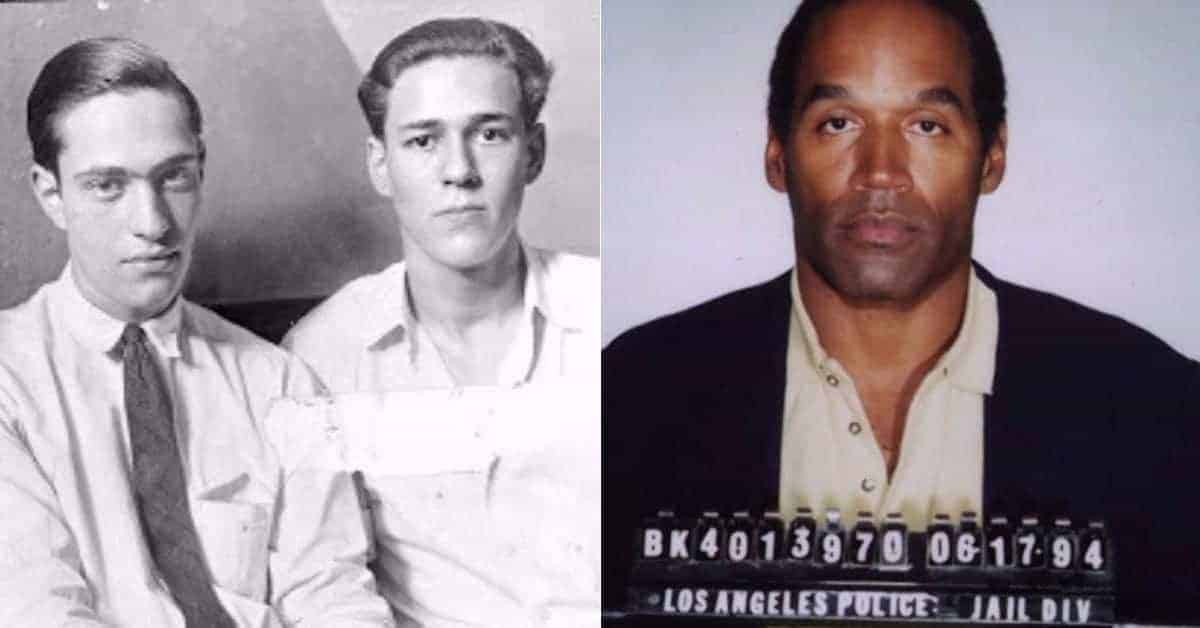During the 20th century, numerous court cases in the United States have been dubbed the “trial of the century.” First used in 1907, the moniker has been used to help sell newspapers and gain international attention. Most of the cases labeled “trial of the century” involved crimes of passion, challenges to ideology, and heinous and unthinkable acts. With intense media coverage, most of the court cases are discussed in the court of public opinion, which does not always align with the actual ruling of a case. Below are five court cases dubbed “trial of the century” that shocked Americans and the world.

1. Harry Kendall Thaw 1907
Harry Kendall Thaw displayed unusual behaviors. He enjoyed hurling heavy household items at servants, had outrageous temper tantrums, and conversed using baby talk. Thaw was born into an extremely wealthy coal and railroad family in 1871 near Pittsburgh, Pennsylvania. The Thaw family wealth kept most of Harry’s stays at asylums and extravagant, sexual, and violent escapades out of the newspapers. Thaw was expelled from Harvard University due to his “immoral practices,” he became a drug addict injecting himself with a combination of morphine and cocaine, and he visited brothels frequently and participated in sexual bondage and long drinking binges.
One evening, Harry Thaw became infatuated with Evelyn Nesbit, a showgirl and model. Thaw’s admiration became obsessive and he repeatedly attended the show, each time bringing Nesbit luxurious gifts. After Nesbit suffered an appendectomy, Thaw convinced her to travel with him through Europe as his guest. During their courtship, Thaw had made it clear to Nesbit that he valued female chastity above anything else. While the couple was in Paris, Nesbit told Thaw about Stanford White, a man Nesbit knew and believed to be out to get him. Nesbit claimed that White got her drunk and then had his way with her. Thaw was enraged.
While in Europe, Thaw locked Nesbit up in a room, whipped her, and over two weeks raped her repeatedly. Despite his violent behavior, Nesbit agreed to married him and they were wed on April 4, 1905. In June the following year, on the evening before they left for Europe, Thaw and Nesbit attended a show. When Stanford White arrived and took his unusual table, Thaw eerily focused on him. During the finale of the performance, Thaw approached White and shot him three times. Part of White’s face was shot off and blood was everywhere. Thaw stood over the body proclaiming that he had rid the world of the man that ruined and abandoned his wife. Thaw believed he was a hero.
Newspapers ran outrageous stories about the murder, Nesbit, and Thaw. Yet, throughout the smear campaign, the torrid details of Thaw’s sexual and violent exploits were not printed. Harry Thaw was charged with first-degree murder and held without bail. While awaiting trial, Thaw’s wealth influenced his imprisonment where he ate food from Delmonico’s restaurant, wore his own tailored clothes, and slept in a brass bed. The publicity surrounding the murder forced the judge to sequester the jury, a first in American history.
Thaw stood trial twice for the murder of Stanford White. The first trial held from January 23-April 11, 1907, concluded in a deadlocked jury. From January to February 1, 1908, Thaw stood trial for a second time where he was found guilty by reason of insanity. The judge sentenced Thaw to life at the Matteawan State Hospital for the Criminally Insane in Fishkill, New York. In 1910, Thaw petitioned for release from Matteawan. His request was denied. With the help from his mother, Thaw escaped to Canada. Upon his return to New York, he was sent to a mental asylum in New Hampshire.
On July 16, 1913, Thaw was released after a jury found him sane. In 1916, Thaw was once again admitted to an asylum for kidnapping and sexually assaulting a 19-year-old boy. Declared sane, he was released in 1924 and began working in film production. Eventually, Thaw moved to Miami where he died in 1947. Thaw’s life influenced several movies and was the inspiration for E.L. Doctorow’s 1975 historical fiction, Ragtime.

